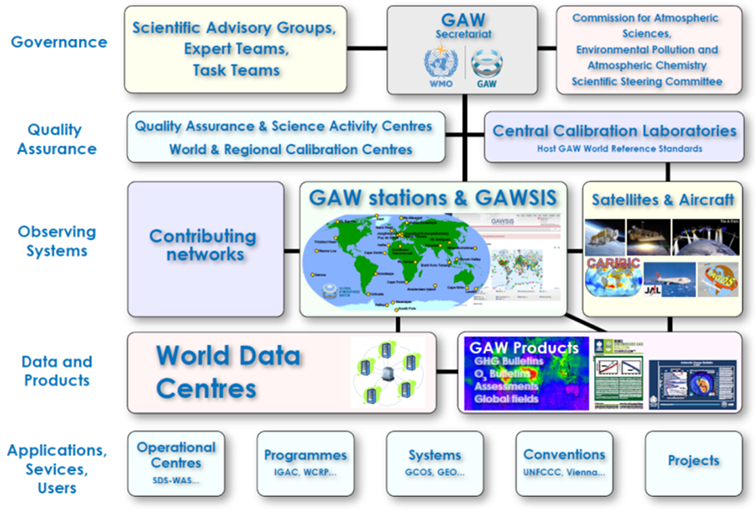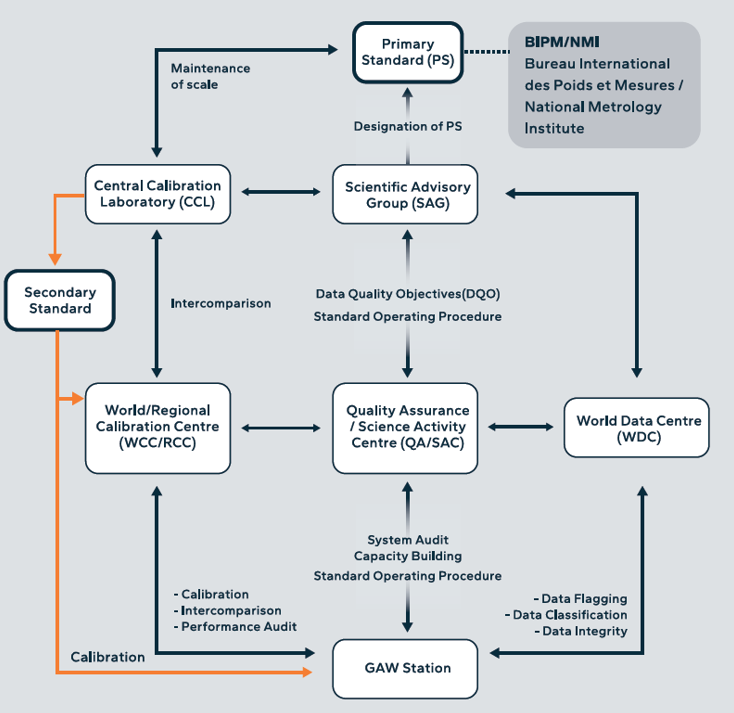About WCC-SF6
home
WCC-SF6
About WCC-SF6
-
 WMO/GAW programme
WMO/GAW programme
-
The Global Atmosphere Watch Programme (GAW) of the World Meteorological Organization (WMO) has a unique long-term international framework that provides the technical
basis for integrated observations, analysis and assessment of atmospheric chemical composition. The missions of the GAW, as described in the WMO Global Atmosphere Watch (GAW)
Strategic Plan: 2016 - 2023 (GAW Report No. 172), is to reduce environmental risks to society and meet the requirements of environmental conventionsp;
strengthen capabilities to predict climate, weather and air quality; and contribute to scientific assessments in support of environmental policy.
And these missions will be achieved through maintaining and applying global, long-term observations of the chemical composition and selected physical
characteristics of the atmosphere; emphasising quality assurance and quality control; delivering integrated products and services of relevance to users.
 Components of the WMO/GAW Programme
Components of the WMO/GAW Programme-

Figure 1. Components of the WMO/GAW Programme -
GAW research activities are directed towards conducting observations to document changes in
atmospheric composition, continuous improvement of the observational and data management
infrastructure, analyses of the data to improve knowledge on the processes controlling atmospheric
composition change, and the development of GAW products and services. These research activities
are supported through the infrastructure reflected in Figure 1, which includes observing systems
supplemented by a set of Central Facilities supporting the quality assurance system, a data
management system, advisory groups, expert teams and a steering committee.
General governance of the programme is organized through focal areas. Various GAW expert groups exist under the oversight of the WMO Commission for Atmospheric Sciences (CAS) and its Environmental Pollution and Atmospheric Chemistry Scientific Steering Committee (EPAC SSC). EPAC SSC takes the responsibility for the programme strategic leadership and coordinates cross-cutting thematic activities and overarching activities in GAW.
 Quality Management Framework
Quality Management Framework- The WMO/GAW quality assurance system includes five types of central facilities dedicated to six groups of measurement variables, which are operated by WMO Members. Its key role is played in the quality assurance system by World Calibration Centres (WCCs), which assists WMO Members in assuring the quality of observations and in particular in establishing observations traceable to the WMO/GAW Reference Scale.
-

Figure 2. Elements of the Quality Assurance system, AQ activities and workflow in GAW
 World Calibration Centre for Sulfur Hexafluoride (WCC-SF6)
World Calibration Centre for Sulfur Hexafluoride (WCC-SF6) World Calibration Centre for Sulphur hexafluoride (WCC-SF6) is one of the central facilities in the World Meteorological Organization / Global Atmosphere Watch (WMO/GAW) programme, since October 2012. World Calibration Centres for Sulfur Hexafluoride conducts following activities:
World Calibration Centre for Sulphur hexafluoride (WCC-SF6) is one of the central facilities in the World Meteorological Organization / Global Atmosphere Watch (WMO/GAW) programme, since October 2012. World Calibration Centres for Sulfur Hexafluoride conducts following activities:
-
a) assist WMO members operating WMO/GAW stations to link their sulphur hexafluoride (SF6) observations to the WMO/GAW reference Scale through comparisons with standards calibrated against the primary/secondary standards maintained by the Central Calibration Laboratory for SF6;
b) assist the WMO/GAW Scientific Advisory Group (SAG) on Greenhouse Gases in the development of the quality control procedures required to support the quality assurance of SF6 measurements and ensure the traceability of these measurements to the corresponding primary standard;
c) maintain laboratory and transfer SF6 gas standards that are traceable to their respective primary standard(s);
d) perform regular calibrations and inter-comparison campaigns involving the WMO/GAW stations/laboratories;
e) assist in provision of training and long-term technical help for WMO/GAW stations; and
f) make public its involvement in the WMO/GAW Programme (e.g. on its websites, in its newsletters, etc.)